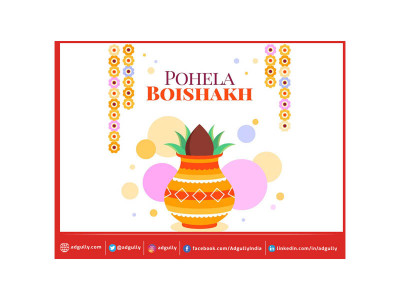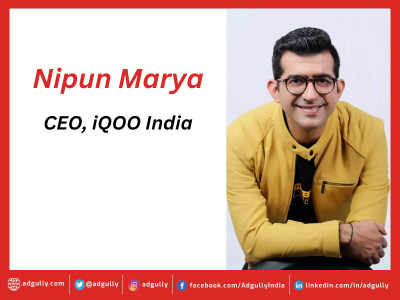TV and Radio add to the Pohela Boishank and Bihu festive fervour in the East markets
The country is celebrating the traditional new year in different regions today (April 14) and tomorrow (April 15), while it is Baisakhi in Punjab, it is Puthandu or Puthuvarudam in Tamil Nadu, Vishu in Kerala, Bihu in Assam and Poila (Pohela) Boishakh or Noboborsho in West Bengal.
Adgully seeks to bring the flavour of the New Year celebrations in the East through a two-part series, wherein we take a look at brand activities and what kind of content strategies media platforms have drawn up this year.
After two years of COVID restrictions, West Bengal is set to enthusiastically welcome Pohela Boishakh, which brings with it a renewed sense of enthusiasm and hope leading the way for a fresh new start. This year, the day enters the 1429 year as per the Bengali calendar. Going back to when it all started, it was during the rule of Mughal emperor Akbar that Fathullah Shirazi, the royal astronomer, was asked to make a new calendar by amalgamating the Hindu solar calendar and the Islamic lunar calendar, giving it the name Fasholi Shan or the harvest calendar.
On this day, the Mangal Shobhajatra is organised in Bangladesh. It is a procession organised by the students and teachers of the Faculty of Fine Arts of Dhaka University and occurs at the dawn of the first day of the Bengali New Year. This is recognised by the UNESCO as a cultural heritage.
The various traditions of this day in Bengal involve waking up early, taking bath, wearing new clothes or notun jama, praying to the rising sun, seeking blessings from elders, relishing Bengali cuisine in lavish feasts with friends and family, and much more. People greet each other with “Shubho Nobo Borsho”. It is also the time of the year when the business community opens new account books. It is an auspicious day for them as they hold special rituals, where they invite guests and their customers and distribute sweets among people.
In Assam, the days leading to Rongali or Bohag Bihu – which starts with Uruka, the first day, on April 13, Goru Bihu (worshiping cows) on April 14 and the New Year on April 15 – see a massive shopping frenzy, especially of traditional garments, the ever-present Gamocha, traditional jewellery, as well as sweets like Pitha, Narikol Laru, etc. Bihu songs and the sounds of the dhol and pepa (buffalo horn) reverberate in the air. In the evenings, Bihu sanmelans are organised everywhere, where a variety of cultural shows are held and which have started to see a heavy brand presence in recent years.
Restaurants are seeing busy times and increasing clientele. With Covid restrictions being lifted, crowds are seen thronging the markets again.
To celebrate this unique festival, television channels, print media as well as radio platforms have also come up with specially curated content to cater to the joyful hearts and minds of the people. In 2021, amid the Omicron wave, Zee Bangla held a virtual ‘Probhat Pheri’ in West Bengal, which celebrated the distinguished art forms of Bengal. Star Jalsha also had special programming.
Speaking on the programming line-up for Poila Baishakh this year, Arindam Nag, Brand Marketing at 91.9 Friends FM, said, “Poila Baishakh is always a special day. We celebrate it musically all throughout the week. This year, too, we are celebrating Poila Baishakh with a lot of new musical experience and engagement – 16 Ana Khanti Bangali.”
There will be contests held every hour, where two selected listeners (chosen through WhatsApp registration) shall debate on various fields like Fashion, Food, Literature, Movies, Sports, and Music, etc. The best answers shall have winners gratified as ‘16 Ana Khanti Bangali’. “The soundscape will be more on Bangla music and content. There will be celebrities all day talking about their Naboborsha celebration plans,” Nag added.
He further said, “There will be Poila Baithak, a full-fledged Baithak Adda on the eve of Poila Baishakh on Digital with singers, chefs, entrepreneurs, as well as people from different walks of life. The adda will celebrate the spirit of Poila Baishakh, giving the flavour of a typical adda, which is the essence of Noboborsho. Being the only Live station of the nation, we stream the entire programme live on our social media platforms connecting hearts beyond geography.”
Sharing about their content strategy for this year, Nag said, “We are a complete CHR station with a blend of good music (mix of Hindi & Bengali and towards weekend nights it is English) and quirky content served with lots of warmth and closeness. Our new positioning is “Beyond words”, which we integrate across station properties to daily show content to uniformly deliver a pre-decided proper directional thought for our listeners. Our short, tight and crisp approach towards delivering content starting from show links to driving different properties has garnered good engagement across all platforms starting from on air to digital.”
“The same has been implemented in our Bengali New Year station property building higher level of engagement both on air and on digital to capture the happy festive mood of the city with a unique twist attached to it,” he added.
On being asked about the listenership frequency in the Covid times, he said, “Even during Covid times we were the only station which was live all through 24x7 on air as well as on various digital platforms, connecting live and engaging with listeners. We have seen a surge in listenership compared to the pre-Covid times due to our continuous LIVE engagement and connecting listeners.”
In the broadcast space, Colors Bangla will be hosting its uniquely curated line-up of shows from April 15 to 18 under the ‘Baishakhe Bajimat’ umbrella, portraying the small wins in the lives of female protagonists who have refused to give up in the face of adversities. Speaking on ‘Baisakhe Bajimat’, Sagnik Ghosh, Business Head, Colors Bangla, said, “We have created “Baisakhe Bajimat” to bring in the optimism and positivity in the minds of the viewers through our protagonists. The content line-up has been curated to showcase the journey of our protagonists who never give up in the face of adversity. We are ecstatic to be able to provide such an intriguing roster of shows that will bring entertainment and a diverse range of content that will keep families engaged and happy in this festive spirit.”
TV9 Bangla will feature a documentary, titled ‘Hutomer Kolketai’, on the occasion of Poila Baishakh. A TV9 bangla spokesperson said, “Kolkata, a city where the era of modernism was inaugurated in the country, is also a city where feudal decadence and western modernism cohabited for a fairly long period. Authors such as Kaliprasanna Singha aka Hutom had written about it in his own inimitable style. More than 150 years have passed since his landmark Hutom Pyachar Naksha was published. The city has changed beyond recognition after that book appeared. But there are some spots in the city where time appears to have stopped abruptly. Hutom had started his book with reference to the Chaitra Sankranto festivities marking the end of the Bengali year. His composition dwelt on the practices of the contemporary feudal babus and the idiosyncrasies, mostly salacious, of the citizens. The city was then rocked by another scandal. Plays were written, songs composed, and ribald literature thrived on the relation between Madhav Chandra Giri, a mohant of Tarakeswar and his wife Elokeshi that culminated in her murder by her husband. TV9 Bangla went back in time to retrace the colourful past.”
Meanwhile, in Assam, news channels, which also air movies and entertainment shows during the afternoon slots and also in the evenings on weekends, have been airing Bihu song and dance programmes, interviews with artists and live and recorded telecast of performances from Bihu Sanmelans across the state. There are also shows devoted to showcasing the latest trends in garments, jewellery anc cuisine.
Tomorrow: Brands and New Year festivities in the East


















Share
Facebook
YouTube
Tweet
Twitter
LinkedIn